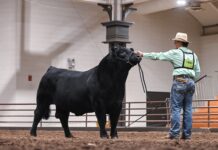BURTON, Ohio — These days, it’s all about being green. From our water bottles to our vehicles, Americans look for products that are kind to the environment, promote conservation and create sustainability.
As the green movement picks up steam, a farm’s carbon footprint — the amount of greenhouse gases produced during daily operations — is continually placed under the microscope of public opinion. Whether you produce crops or meat or milk, consumers want to know the environmental impact of your operation. How much fuel goes into getting that gallon of milk on the table? What happens to the manure from your farm? How much fertilizer does it take to grow an ear of corn?
At the Ohio Dairy Producers district meeting Nov. 13 in Geauga County, veterinarian and Elanco representative Tom Bailey talked to dairy farmers about their role in sending a positive environmental message to consumers.
“You know, most people don’t understand agriculture, so they have a neutral to negative feeling about agriculture,” he said.
But farmers can help overcome that negativity through simple conversation with consumers. Don’t argue, don’t debate, just talk about it.
“Who makes the biggest impact on consumers?” Bailey asked those at the meeting. “You guys. Coming straight from you as dairy producers.”
So, what do you need to know before starting one of these conversations? Well, you need to be armed with the facts.
Here are few items to help you along the next time someone asks about air pollution, manure management or the use of natural resources on your dairy farm.
Are there a lot of corporate farms in the U.S.?
No. In fact, 99.5 percent of dairies in this country are family farms.
How much do dairy farms contribute to greenhouse gas emissions?
Here’s the bottom line: Dairy farms create 0.066 percent of the greenhouse gases emitted in the U.S., according to Bailey.
If you’re curious about the background of that figure, start with the total amount of greenhouse gases in the U.S. Of that total amount, 6 percent is produced by the agriculture industry.
Of that 6 six percent, cattle contribute 33 percent. Of the amount produced by cattle, the dairy industry accounts for 11 percent.
So when you consider the total amount of greenhouse gases, the dairy industry contributes 0.066 percent of overall emissions.
Are farmers trying to improve their environmental impact?
Bailey said the carbon footprint of a gallon of milk has been reduced by 66 percent since 1944.
In 1944, U.S. dairy farmers produced 117 billion pounds of milk with 25.6 million cows. In 2007, U.S. dairy farmers produced 186 billion pounds of milk with 9.2 million cows.
That’s a 40 percent increase in milk production with 66 percent less cows.
How does this happen? It happens through efficiency — technology, genetics and innovation have given modern farmers the opportunity to produce far more milk with far fewer animals.
How is efficiency related to a farm’s carbon footprint?
Let’s look at it this way: If U.S. farmers would take 1 million cows and dedicate the technology to make sure each of those cows produced 10 additional gallons of milk every day, it would reduce the environmental impact by of dairies by 9 percent, according to a Cornell study.
That’s the equivalent of removing 391,000 cars from the road or planting 291 million trees.
The technology to make cows more efficient milkers includes everything from heat abatement to genetics to feed.
If those 1 million cows could become more efficient and produce 10 more gallons of milk each day, farmers would need 334,000 few animals to make the same amount of milk produced now.
Less animals would mean 2.5 million fewer tons of feed, 540,000 fewer acres of land and 3 million fewer tons of manure.
So what can individual farmers do to make a difference?
If a dairy farmer with 150 cows dedicates the technology to make each cow produce an additional 10 gallons of milk per day, he would eventually be able to sustain his current production with fewer animals. This reduces the carbon footprint of his dairy by 180 metric tons.
That’s the same as taking 38 cars off the road or planting 28,375 trees annually.
The farmer would need 245 fewer tons of feed, 53 fewer acres, 132,000 fewer gallons of water to run his farm.
This is nice, but I don’t own cows. How do these issues affect me as a consumer?
Consumers are tied to the environmental impact of dairy farmers.
A family of four typically drinks 274 gallons of milk per year. If that milk comes from an efficient farmer who is doing more with less, the family’s carbon footprint is reduced by 345 pounds of carbon dioxide.
That’s the same as planting 25 trees every year.









